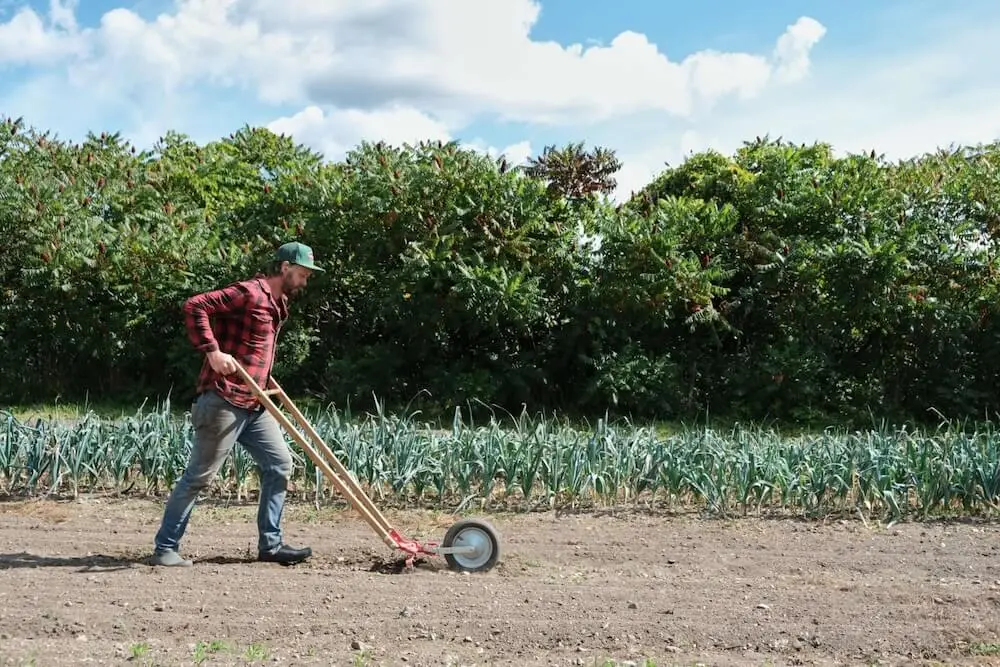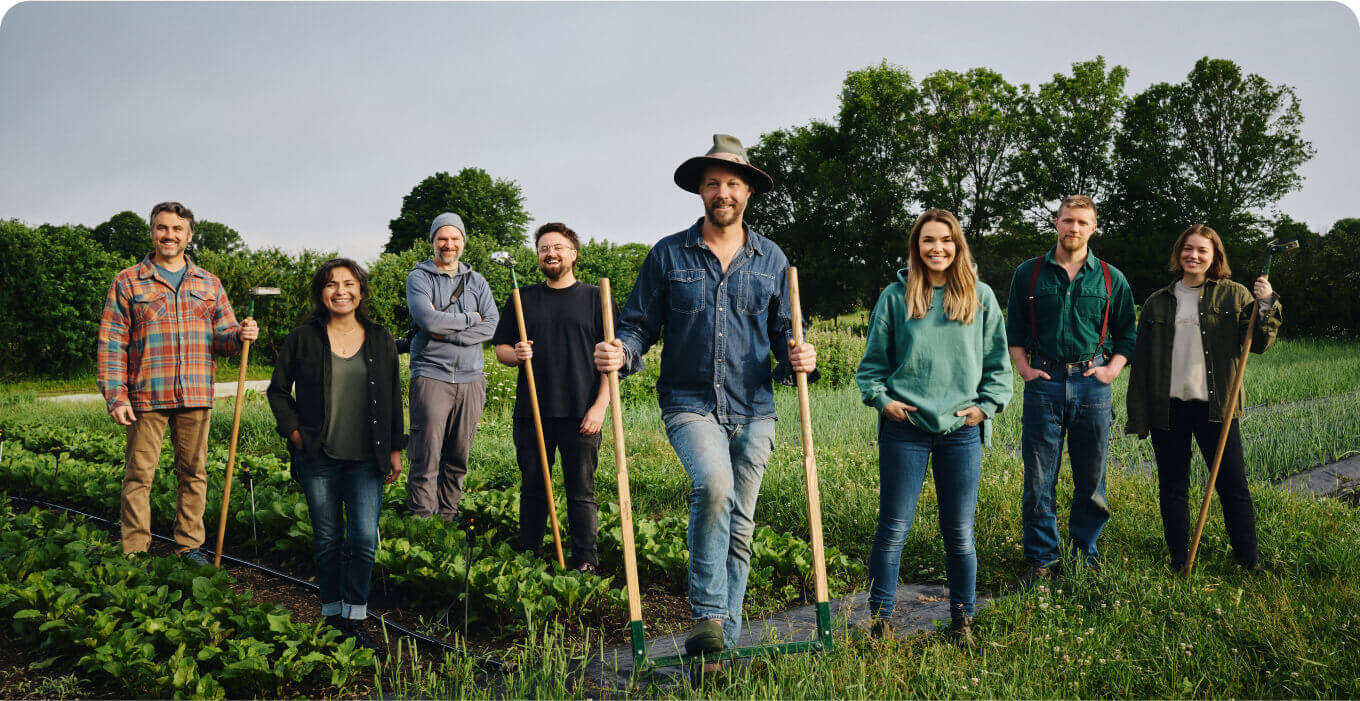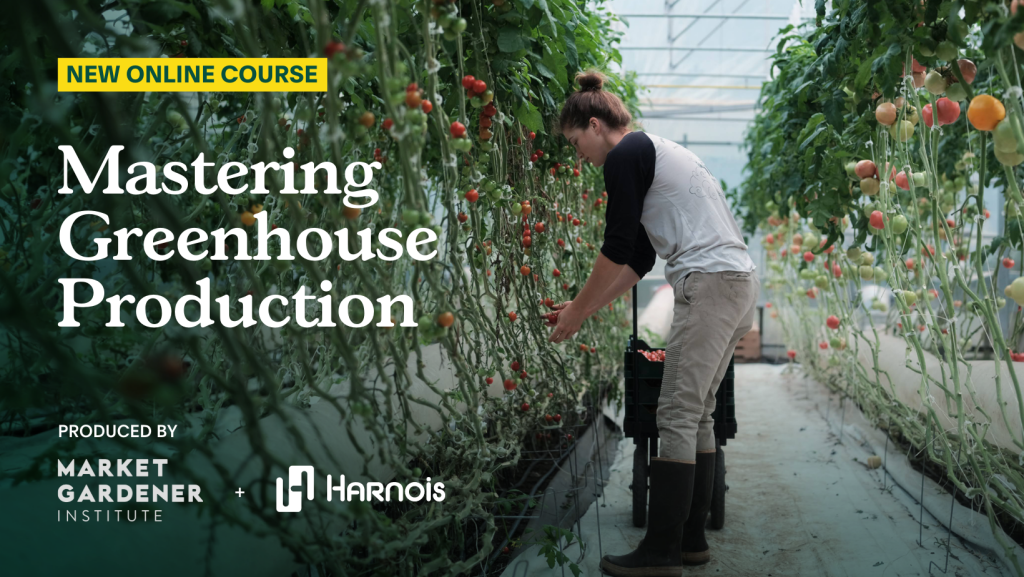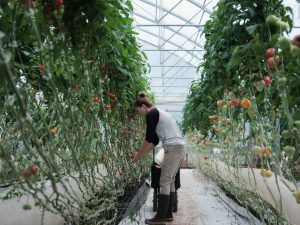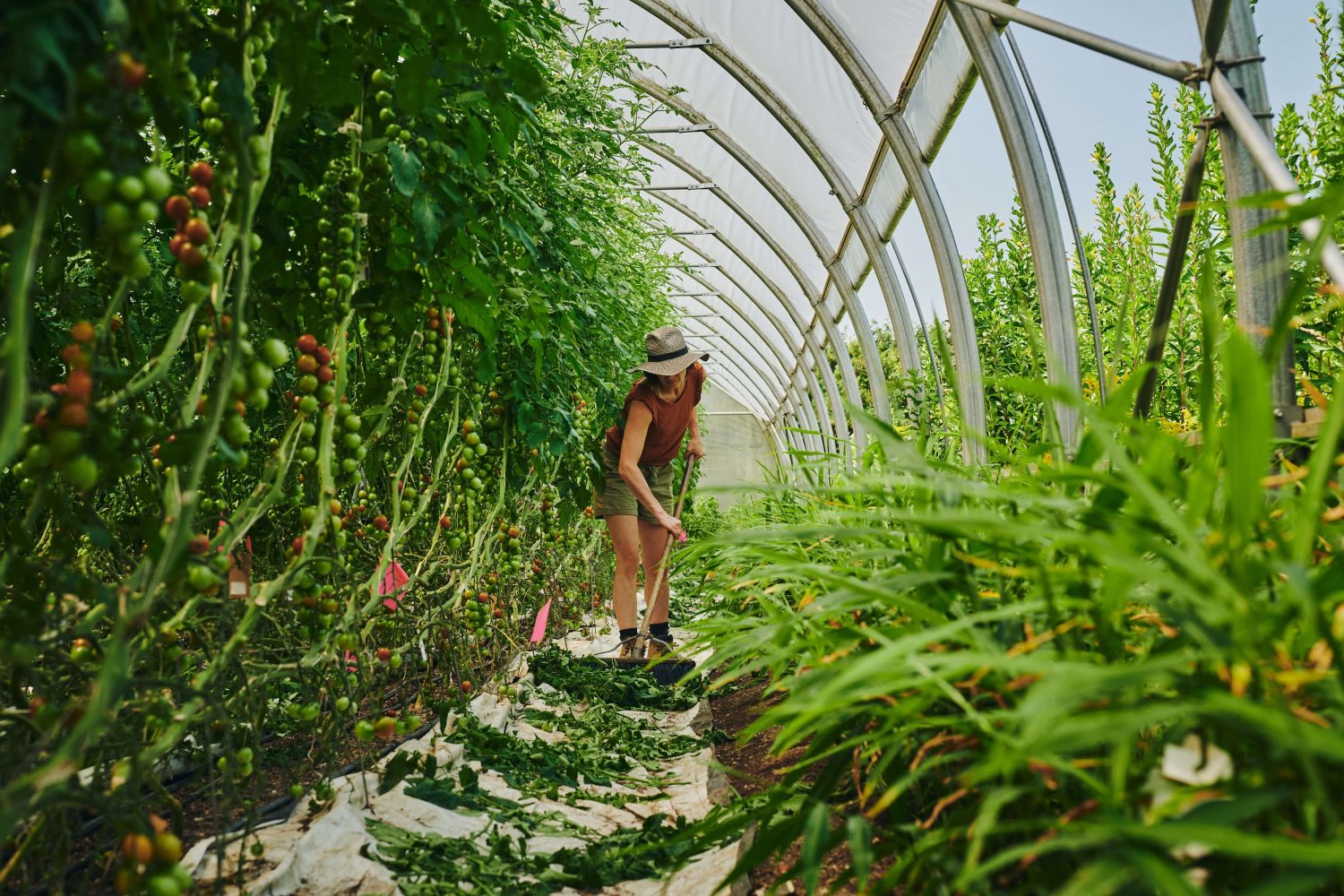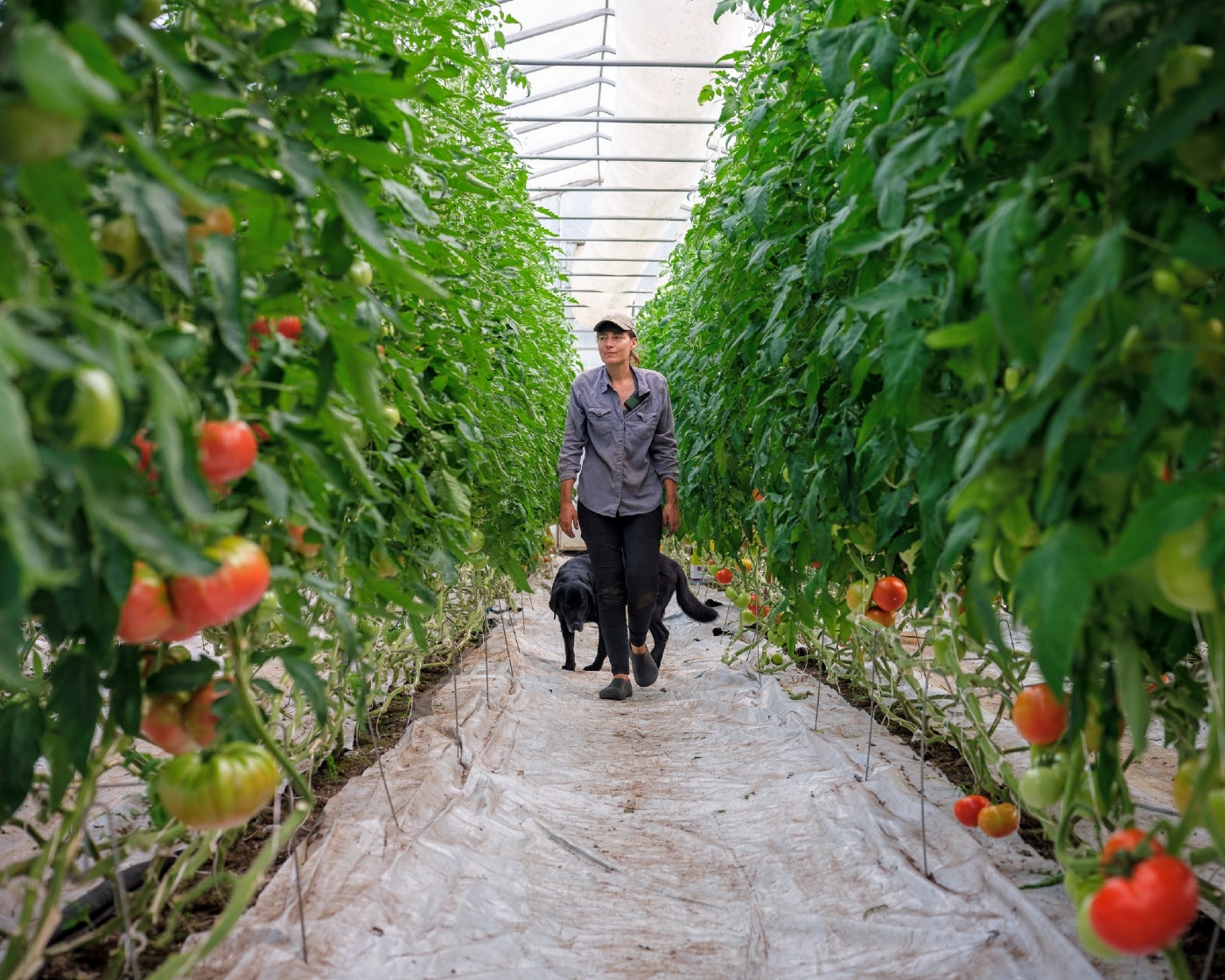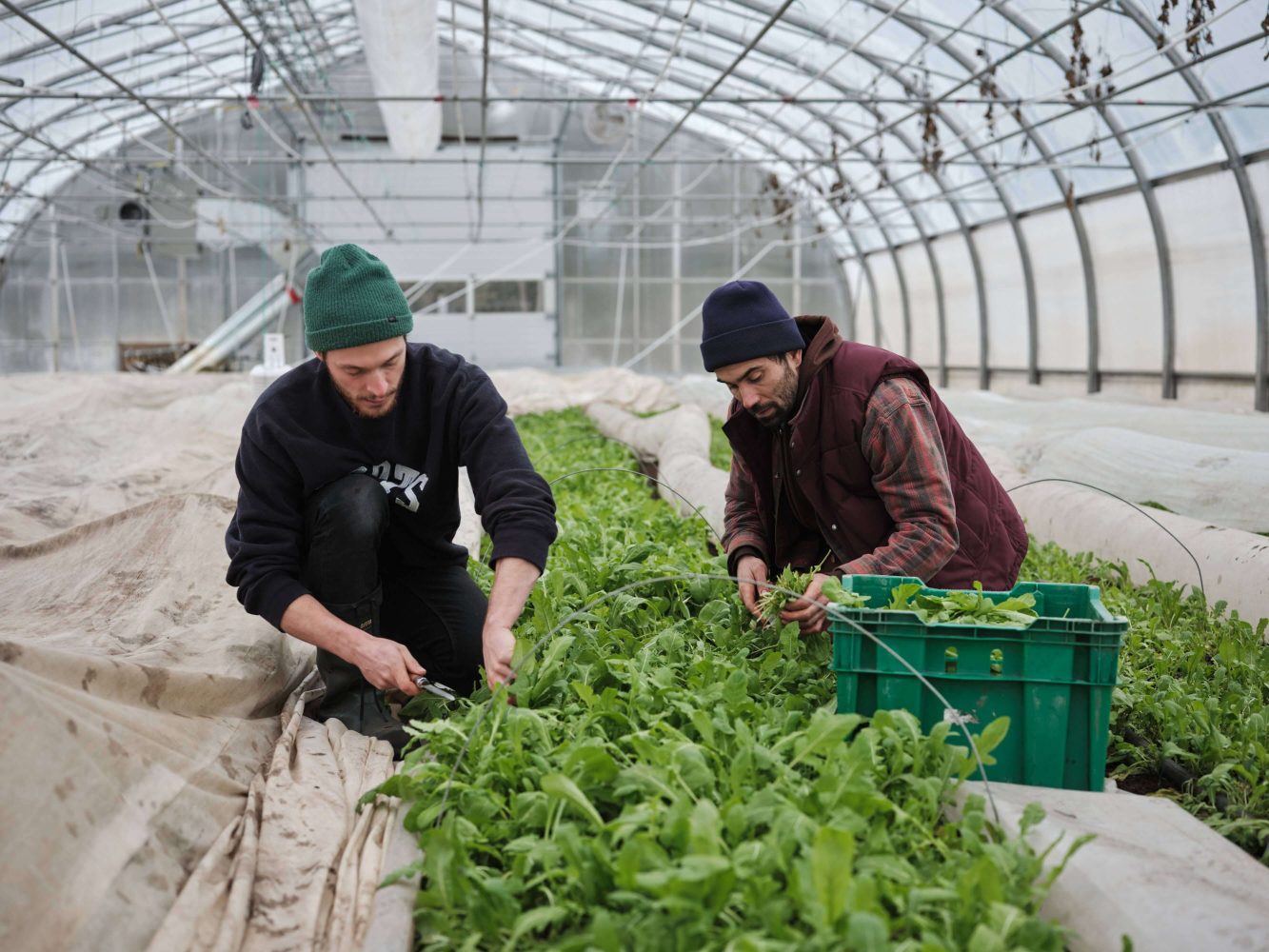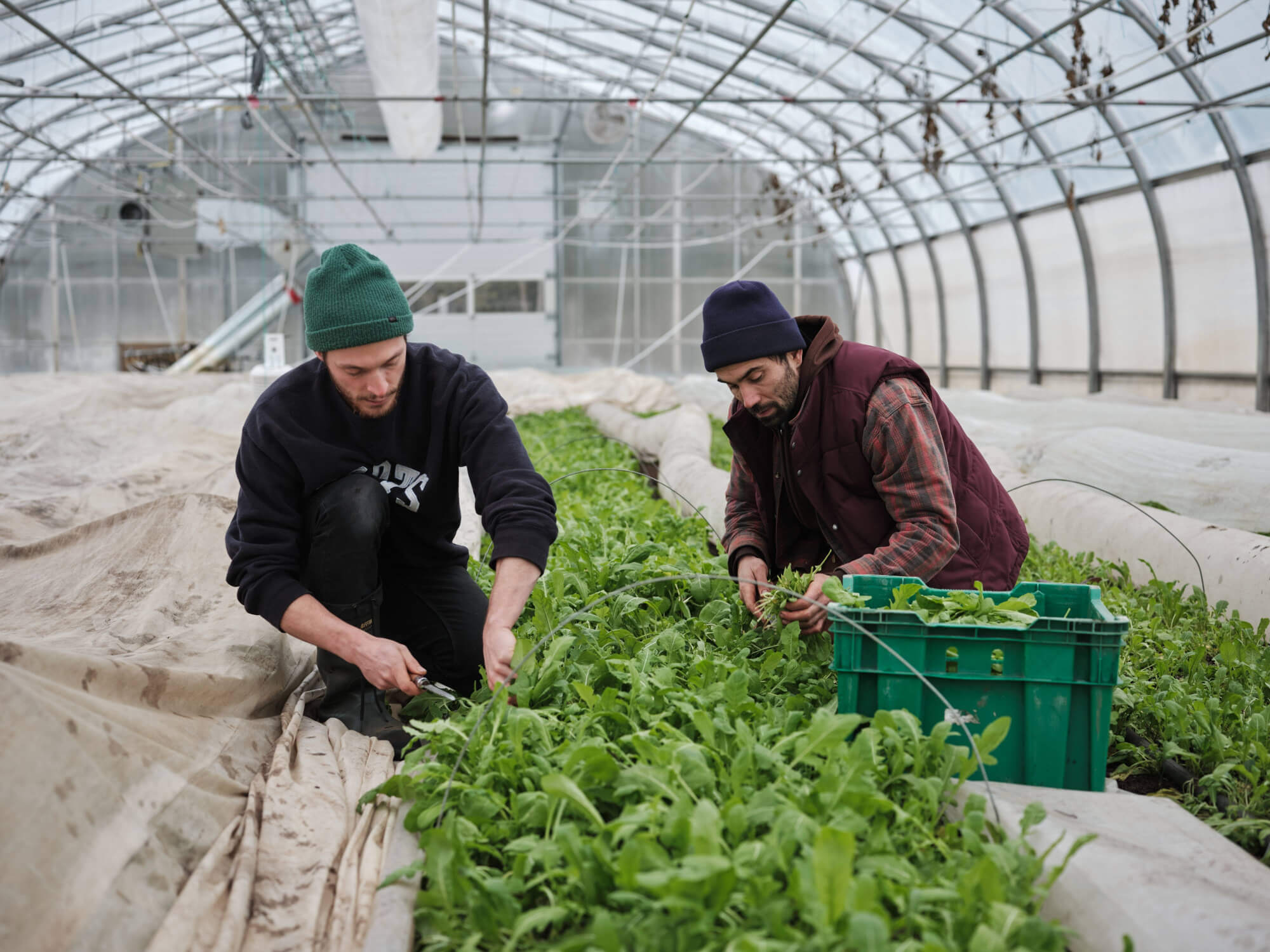What You’ll Learn in This Greenhouse Growing Guide
Greenhouse farming is one of the most profitable investments you can make as a market gardener. It allows you to extend your growing seasons, protect your crops from unpredictable weather, and achieve consistent yields year-round. With the right greenhouse structure and proper management, a greenhouse can elevate your farming business by offering consistent high-quality produce.
A big part of my market gardening playbook—and the financial success I’ve had over the years—comes down to learning and applying the best greenhouse growing strategies. I saw the power of this early on at Les Jardins de la Grelinette, where we used our tunnels to extend the season and boost our crop quality. Later, at La Ferme des Quatre-Temps, I had the chance to go even deeper, training a team of growers to master these techniques and push the limits of what a small-scale farm can produce. Greenhouse growing is a field full of untapped potential, just waiting to be unlocked.
This greenhouse guide is here to help. Whether you’re just starting out or looking to optimize your current setup. Below, you’ll find the key questions we’ll explore in this greenhouse growing guide—each one packed with insights from years of hands-on experience.
Why greenhouses are a smart choice for market gardeners?
I’ve found that greenhouses provide crucial protection for crops, especially with the increasing unpredictability of weather patterns. They also allow for better control over the growing environment, which helps me to increase yields and maintain consistency in production. Ultimately, using greenhouses extends the growing season, enabling me to supply profitable crops earlier and later in the year.
How do you select the right greenhouse for your farm?
Choosing the right greenhouse is essential, and it starts with careful planning. In my experience, determining whether you need a standalone or gutter-connected structure is a key decision, along with considering the size that best suits your operation. The covering material, access, insect nets, and foundation are all critical elements I carefully evaluate to ensure optimal performance.
What are the essential systems required to run a greenhouse efficiently?
Efficiently operating a greenhouse requires implementing the right systems including heating, cooling, ventilation, and air circulation. Each system has a role to play in order to keep your crops comfortable and productive, no matter what’s happening outside.
Which crops are best to grow in a greenhouse?
Over the years, I’ve experimented with a wide range of crops in my greenhouses and have identified some that thrive particularly well—including tomatoes, cucumbers, peppers, eggplants and baby ginger.
Scaling and optimizing your operation for maximum profitability
Finally, in this greenhouse guide, I’ll share what I’ve learned about scaling greenhouse operations and optimizing them for maximum profitability.
In this in-depth greenhouse guide, I will cover all of these points.
Greenhouse Guide Principle #1: Why Invest in a Greenhouse?
I often tell growers that a greenhouse, especially for tomatoes, can be one of the best investments on the farm. I’ve seen it time and time again—both in my own operation and while working with growers who’ve asked for guidance. A 35 x 100 ft tomato tunnel, managed with care and intention, can bring in anywhere between $15,000 and $40,000 in net profit. And when you sell directly—at markets, through a CSA, or to local restaurants—that number really starts to make sense.
Maybe you won’t hit those numbers right out of the gate. That’s normal. Like anything in farming, it takes time to dial things in. But those profit margins? They’re totally achievable. It’s exactly what I teach in my online course Mastering Greenhouse Production —how to apply professional techniques that really move the needle.
And it’s not just tomatoes. When you crunch the numbers for cucumbers, peppers, eggplants, and even pole beans—especially when you grow them using smart, intensive methods—the yield potential gets really exciting. A stronger bottom line alone should be enough to make you seriously consider investing in a greenhouse and learning how to grow in one the right way.
When done well, greenhouse growing becomes one of the most efficient and resilient ways to scale up production without relying on more land or more labor.
But profitability isn’t the only reason
Protection Against Climate Change
One of the most convincing reasons to invest in a greenhouse is simple: protection. When you’re farming in the open, you’re at the mercy of the weather—and lately, that mercy is running thin. Heatwaves, late frosts, heavy rain, hail… they’re not rare events anymore. They’re happening more often, and when they hit, they can wipe out a crop overnight. I’ve seen it happen too many times to count, and honestly, I don’t even feel the need to warn growers anymore—it speaks for itself.
Whether or not you believe climate change is driven by human activity, the reality is that the climate is changing—and not in our favor. As growers, we’re already feeling the consequences, and they can be devastating. A greenhouse isn’t just about better yields—it’s about resilience. A kind of protection gives you more stable, reliable harvests—and less chance of losing a crop just when it’s about to come in strong.
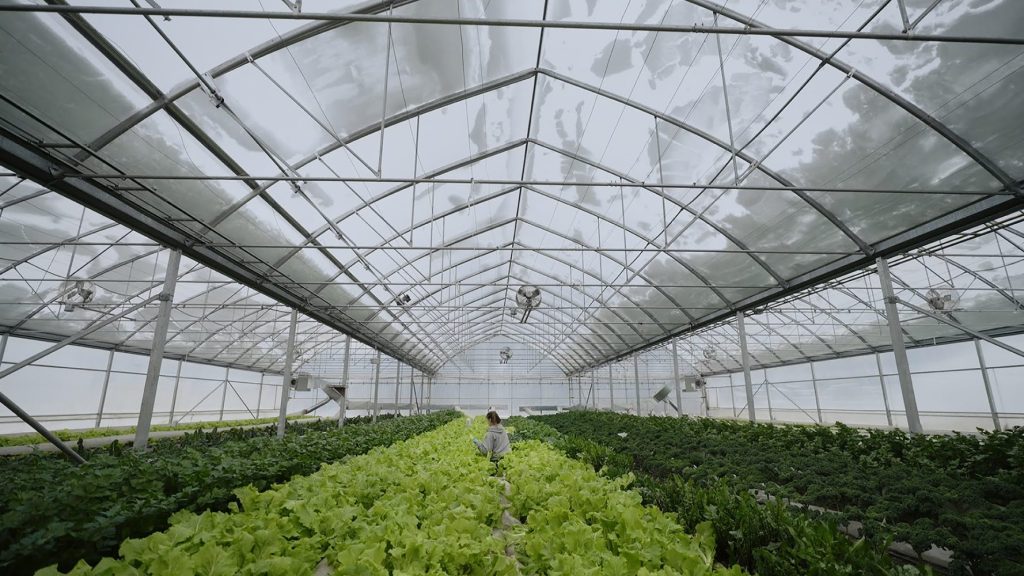
Extended Growing Seasons
Another major advantage of greenhouse farming is the ability to extend your growing season. In traditional outdoor setups, you’re limited by temperature, frost, and changing daylight. But in a greenhouse, you control those variables. That means you can start planting much earlier in the spring and keep harvesting long into the fall.
At La Grelinette, we’re harvesting tomatoes in June—while most field growers are just starting to transplant theirs. That head start? It changes everything. Being first at farmer’s market is huge. You set the price, you grab people’s attention, and you become the go-to for fresh, local produce. I can’t stress that enough.
Late-season harvests matter just as much. Cucumbers are still in high demand in October and November, and thanks to the greenhouse, we’re able to keep supplying them right through the fall. Again—it makes a big difference. Not only for the bottom line, but for the relationship you build with your customers when you’re still showing up at the market while others have packed up for the season.
If you want a deeper dive into how this works, check out this article: Four Ways Your Season-Extension Production Will Benefit From Using Greenhouses
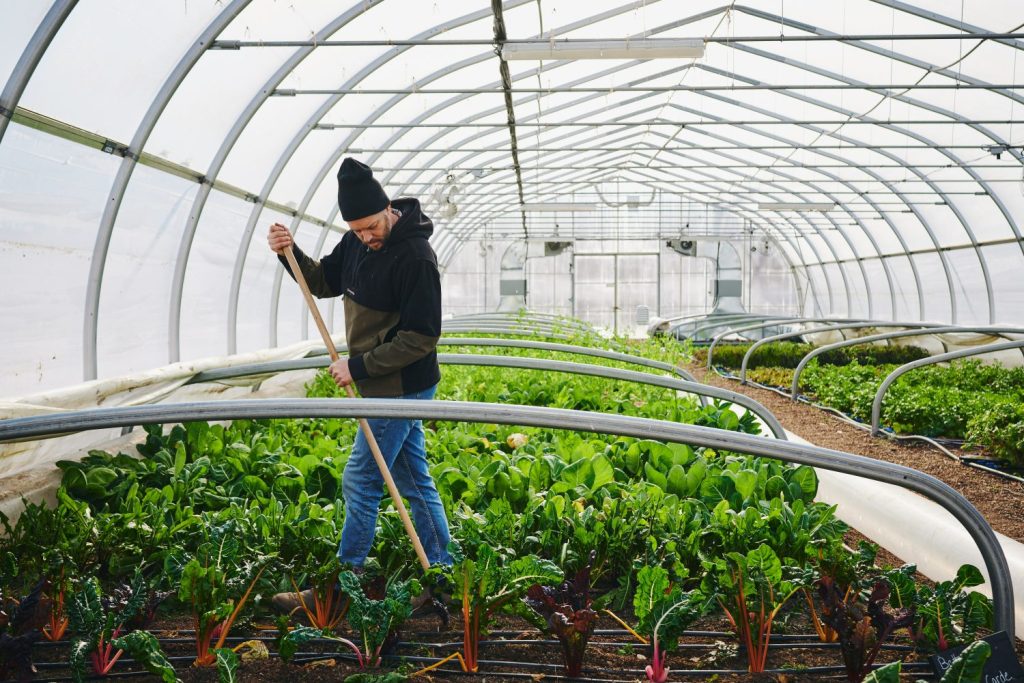
Higher Yields and Consistency
The crops that bring in the most money on any farm—tomatoes, peppers, cucumbers, and, in many cases, fresh beans—thrive in a controlled environment. When you grow them in a greenhouse, they face way fewer disease pressures. Outdoors, these crops are exposed to all kinds of issues: pests, fungal diseases, uneven watering, too much sun or not enough. But inside a greenhouse, you minimize those risks.
What you get in return is consistency. Crops grow at a predictable pace, and the yields are simply better—much better.
For example, greenhouse-grown tomatoes can yield up to 55 kg per square meter in a single season. In comparison, field-grown tomatoes usually cap out at 10 to 15 kg per square meter. That’s a massive difference. And when you combine that yield boost with the stability of a controlled environment, it adds up to stronger productivity and, ultimately, better profitability.
Want to see what this looks like in action? Check out this video from our YouTube channel:
Efficient Resource Use: Growing Better, Not Bigger
This idea has always been at the heart of my approach. If you’ve read my first book, The Market Gardener, it probably sounds familiar. What’s true for the size of your farm is just as true for your greenhouse: instead of expanding with more tunnels, focus on getting more yield from the space you already have. That’s the key.
To make that happen, you need two things: the right techniques and the right systems. Learning how to grow professionally inside a greenhouse is essential—but so is investing in the tools that make it all work. Proper heating (and in some cases, cooling), reliable irrigation, and solid ventilation systems are the foundation. These aren’t extras—they’re the cornerstones of consistent, high-yield production.
One piece that often gets overlooked—and in my opinion, is a total game changer—is automation. Smart climate control systems help you maintain steady temperature, humidity, and airflow, day and night. That kind of precision creates the perfect growing environment and leads to healthier, more productive plants.
If you want to dive deeper into the tech side of this, I wrote an article about it here: How to Use Automation to Increase Your Greenhouse Yields
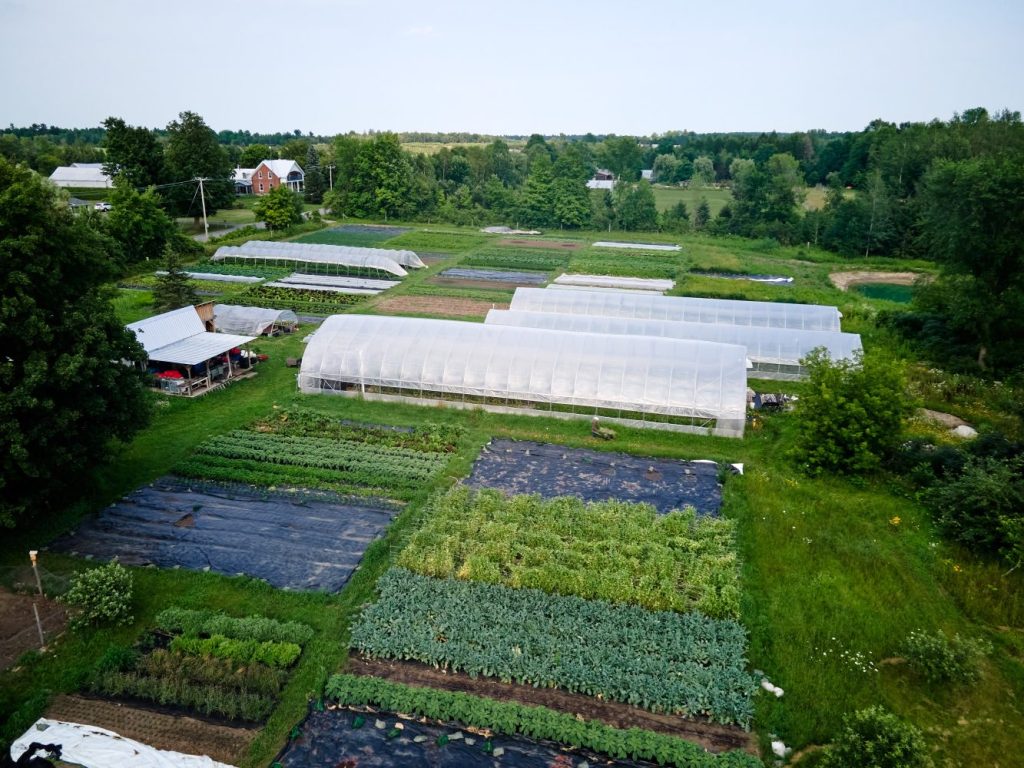
Greenhouse Guide Principle #2: Choosing Your Greenhouse
Choosing the right greenhouse for your farm is a big decision—one that can shape the future of your operation. I learned that the hard way.
Back in my early farming days, I made one of my biggest mistakes: I bought and set up a greenhouse without fully understanding what I needed. It wasn’t the right model for my space or my climate. I didn’t think enough about wind direction, anchoring, or ventilation. We put it up, took it down, moved it, and set it up again. It was a lot of work—and not the kind you want to go through.
That experience taught me just how important it is to slow down and think things through before you make the investment. And it’s part of the reason I teach what I do now—to help other growers avoid the same painful (and expensive) learning curves.
If you want to see a good example of what I’m talking about—and what I wish I’d known back then—check out this video from our YouTube channel.
The pointers below are based on what I’ve learned—through trial, error, and experience. I hope they’ll help you make smarter, more confident choices when it comes to setting up your own greenhouse.
Types of Greenhouses
When it comes to greenhouse options, there are two primary types to consider: individual greenhouses and gutter-connected greenhouses. Each offers distinct benefits, and your choice will depend on the scale of your operation.
1. Individual Greenhouses:
Standalone structures are usually best suited for small to medium-sized farms, like a market garden. They offer a lot of flexibility—you can place them almost anywhere, and they’re generally easier to maintain and manage. For market gardeners using bio-intensive methods, individual greenhouses are a great fit. They let you maximize space and production without needing a huge footprint. Plus, you can customize them easily for temperature control, irrigation, or ventilation.
Expect to pay between $8,000 and $20,000 for a good-quality individual tunnel (30 x 100 ft), depending on materials, features, and if you’re doing the installation yourself or hiring help. Don’t forget to factor in the extras—like end walls, roll-up sides, shade cloth, or even a basic heater. These can add $2,000 to $5,000, but they’re often essential to get the results you want.
2. Gutter-Connected Greenhouses:
These are large, professional-grade structures designed for more serious greenhouse growing. Gutter-connected greenhouses link multiple bays into one continuous space, which improves efficiency and creates a more stable climate inside. While they do require a higher upfront investment, they’re ideal if you’re planning to scale up and grow crops like tomatoes, cucumbers, or peppers at a larger volume. One big advantage is that these structures are modular. You can start with a couple of bays and add more as your market grows and your cash flow allows. That kind of scalability makes gutter-connected greenhouses a smart long-term investment for serious growers.
A gutter-connected greenhouse will start around $30,000 and can go well over $100,000, depending on the size, level of automation, and infrastructure involved. Keep in mind that these greenhouses often need concrete footings, permanent power sources, and automated climate controls, which can significantly increase the overall cost. But the return—especially in terms of yield and quality—can more than make up for it over time.
What Is the Ideal Greenhouse Size and Orientation?
The size and orientation of your greenhouse are key factors in its efficiency and effectiveness. Again here are some key pointers :
- Width and Height: The ideal width for most market gardens is between 30 and 35 feet. This provides enough space to organize crops efficiently and allows for optimal air circulation, which is crucial for controlling humidity and temperature. Height is also an important consideration. Taller greenhouses allow for vertical growth, which is essential for crops like tomatoes and cucumbers, which benefit from being trained onto trellises. Additionally, taller greenhouses help with air circulation and temperature management.
- Length: The length of the greenhouse should align with your farm’s production systems, such as bed systems or crop rotations. A length of between 100 and 150 feet is typical, but longer greenhouses will require more investment in heating and ventilation systems to maintain optimal conditions throughout the entire space.
- Orientation: The orientation of your greenhouse plays a crucial role in maximizing sunlight exposure. In northern climates, positioning your greenhouse with an east-west orientation maximizes sunlight during the winter months when sunlight is at a premium. In warmer climates, a north-south orientation can help provide more even light distribution year-round.
Which Covering Material Is Best for Your Greenhouse?
The material you choose to cover your greenhouse is critical to its insulation and durability.
- Double-Layer Polyethylene: Polyethylene is one of the most commonly used materials for greenhouse coverings due to its affordability and excellent insulating properties. When inflated with an air layer, it provides better insulation, helping to reduce heating costs. Double-layer polyethylene also has UV-resistant properties that protect plants from excessive sun exposure, and it can prevent condensation that can lead to fungal growth.
- Polycarbonate Panels: Polycarbonate panels are typically used for end walls and doors. These panels are more durable than polyethylene and offer better insulation, but they come at a higher cost. Polycarbonate panels help retain heat within the greenhouse, making them especially valuable in regions with extreme winter temperatures.
Greenhouse Guide Principle #3: Essential Greenhouse Systems
Once your structure is up, the real work begins. A greenhouse is only as good as the systems running inside it. Climate control, irrigation, and humidity management—these are not optional if you want consistent, high-quality production. They’re the backbone of a thriving setup.
My advice? Get familiar with these systems before deciding whether or not to invest in them. Too many growers skip this step, thinking they’ll “figure it out later,” only to end up dealing with poor performance, crop stress, and unnecessary headaches. Knowing what each system does—and how it impacts your crop—will help you make smarter choices and avoid costly regrets down the road.
There are several systems you’ll need to consider and understand: heating, cooling, ventilation, and air circulation. Each one plays a role in keeping your crops comfortable and productive, no matter what’s happening outside.
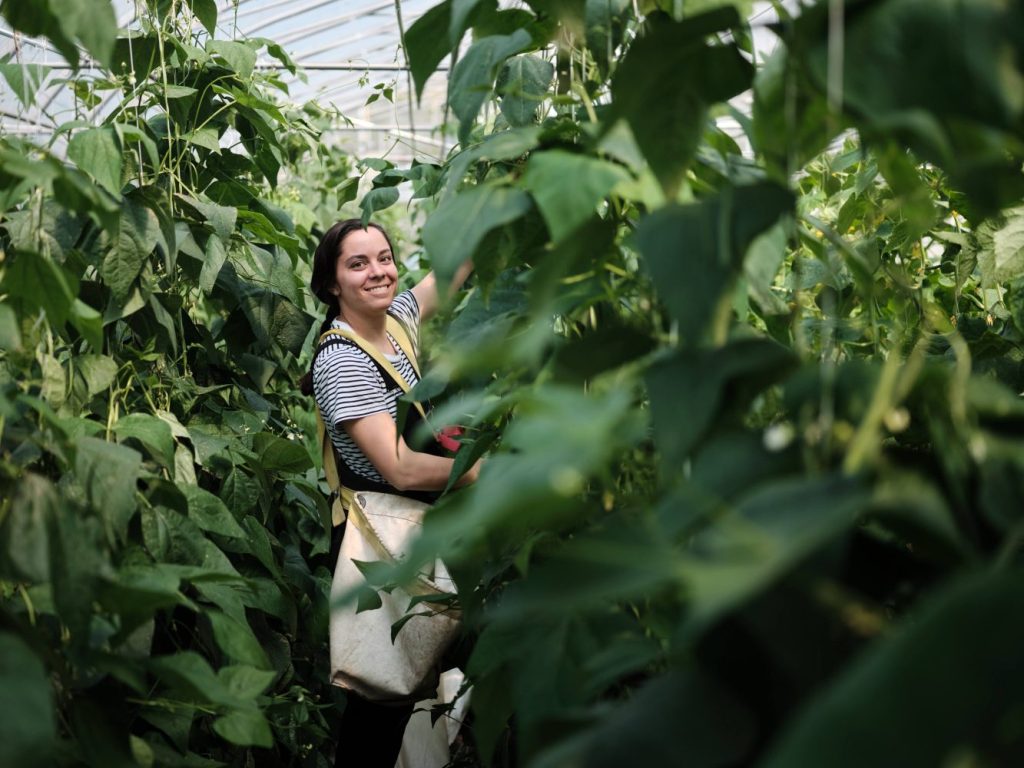
Heating Systems
Propane and natural gas heaters are the most commonly used heating options in greenhouses. These heaters can be paired with heating tubes or radiant floors to ensure even heat distribution throughout the structure. Insulating the greenhouse’s perimeter and north wall is essential to reduce heat loss and improve energy efficiency.
For more insights, see our article What is the Most Efficient Way to Heat Your Greenhouse?
Ventilation Systems
Proper ventilation helps to maintain air circulation and control humidity. A combination of natural ventilation (side and roof vents) and mechanical systems like Horizontal Air Flow (HAF) fans is commonly used to ensure that your greenhouse remains well-ventilated year-round. Positive pressure fans and ventilation shutters are especially effective for cooling in the summer months and reducing excess humidity.
To learn more about greenhouse ventilation, check out this article How To Properly Ventilate Your Greenhouse and Why this is Essential in Your Success
Irrigation Systems
Water is a vital resource in any greenhouse, and efficient irrigation systems are necessary to maintain healthy plants. Drip irrigation is the gold standard for greenhouse farming because it delivers water directly to the base of the plants, minimizing evaporation and water waste. Multiple drip lines per bed ensure that crops receive even watering, which is crucial for maintaining plant health.
Another important consideration is temperature control for irrigation water. Using a tempered water tank ensures that the water you use to irrigate your crops is at an optimal temperature, reducing plant stress, particularly during colder months.
Irrigation is a complex task because each crop must receive the right amount of water at the right time, depending on the level of sunlight on a given day.
To go beyond the essentials shared in this greenhouse guide, we’ve created a free Ebook: Greenhouse Irrigation. Inside, you’ll find practical, actionable guidance on key topics, including:
- Water Source
- Drip Irrigation
- Tempered Water Tank
- The Automatic Irrigation
- How to Calculate Water Requirements
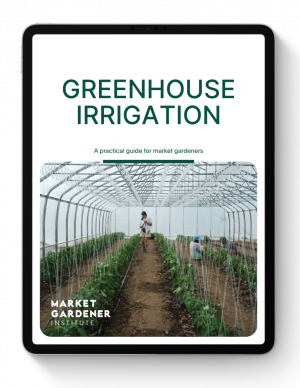
Get your free
e-book today!
Humidity Management
Humidity plays a crucial role in greenhouse farming. High humidity can encourage the growth of fungal diseases, while low humidity can stress plants and stunt growth. A good greenhouse system will include automatic dehumidification cycles that use a combination of heating and ventilation to regulate moisture levels. Misting systems can also be installed in dry climates to increase humidity levels and create a more favorable environment for plant growth.
To learn more about humidity in the greenhouse, check out this article How To Control Humidity In The Greenhouse?
Curious to see what these systems look like on a small farm, you can check this video I made about the greenhouse systems at my family farm La Grelinette.
Automation Systems
Over the years, I’ve come to see automation as one of the smartest moves a grower can make—especially as your greenhouse operation grows. Tools like automated irrigation, climate sensors, and fertigation systems take so much off your plate. They keep your temperature, humidity, and watering schedules consistent, which makes a big difference in plant health and yields. Even better, many systems now let you monitor everything from your phone, so you’re in control even when you’re not on the farm.
If you’re curious how it all works in practice, check out this video: Greenhouse Automation 101
Greenhouse Guide Principle #4: Growing High-Value Greenhouse Crops
Once your greenhouse is set up, what you grow inside it makes all the difference—but it’s not just about the crop. It’s about choosing the right cultivars for greenhouse conditions. This can be the difference between average results and standout success.
Greenhouse growing : Tomatoes
Tomatoes have always been one of the most profitable crops on our farms—both at La Grelinette and La Ferme des Quatre-Temps. But not all tomatoes are created equal. In the greenhouse, indeterminate cultivars—especially cherry and heirloom types—really shine. They produce continuously and take full advantage of vertical growing systems.

This section of the greenhouse guide highlights why tomatoes—especially indeterminate varieties—deserve a leading role in any protected cropping plan.
Over the years, I’ve trialled a lot of tomato cultivars in our greenhouses. Some looked great on paper but didn’t perform. Others quietly became absolute champions. These are the ones I come back to season after season—they deliver on yield, flavor, and reliability. In my experience, greenhouse growing unlocks the full potential of these varieties, offering consistency, protection, and extended harvests that field-grown tomatoes often can’t match.
Here’s a short list, and where I source them.
My go-to tomato cultivars:
- Marbonne (F1): This is one of those varieties I recommend when people ask me what we grow for flavor and structure. It’s a modern take on the classic French heirloom Marmande—the same beautiful ribbing and deep red color, but with much better vigor and disease resistance. The texture is smooth and soft, and the flavor always impresses chefs.I get mine from Johnny’s Selected Seeds.
- Margold (F1): Margold has that stunning heirloom look—yellow skin with red streaks—and it tastes as good as it looks. Think Striped German, but with way better reliability. It’s super sweet, meaty, and very tender. We’ve had great luck with it holding up through long harvest windows. Also from Johnny’s.
- Beorange (F1): Orange slicers are always eye-catching at the market, but this one also tastes great. Beorange strikes a nice balance between sweetness and acidity, and the fruit holds its shape well. Customers love the rich color and flavor, and I like how well it grows in the tunnel. Johnny’s carries this one too.
- Bigdena (F1): If you’re looking for a solid, dependable beefsteak with high yield, Bigdena is it. These plants are vigorous and open, and they pump out large, uniform fruit with excellent internal quality. A great workhorse for market growers. I get this one from Best Seed.
- Rebelski (F1): This one was bred for the fresh market, and it shows. The fruits are a classic red—shiny, ribbed, about 7–8 oz.—and super crack-resistant. If you need something that looks good, tastes good, and holds up to transport, Rebelski is a solid pick. From Johnny’s.
- Sakura (F1): I’ve grown a lot of cherry tomatoes over the years, and Sakura is one of the best for flavor and earliness. It’s sweet without being cloying, has a clean, bright finish, and the fruits are firm but not hard. Customers love them. I get my seeds from Johnny’s Selected Seeds.
- Toronjina (F1): If you want to mix up your cherry tomato colors, this orange one is worth a try. It’s sweet, aromatic, and holds well on the vine. We’ve used it in our color mixes for years, and it’s always a standout. I source it from Vitalis Organic Seeds
- Black Cherry: This is an open-pollinated classic. The deep purple-brown color draws people in, but the flavor seals the deal. It has that rich, almost wine-like depth that keeps folks coming back for more. A reliable and beautiful addition to any cherry mix. I get this one from The Incredible Seed Company.
If some of these techniques are new to you, check out this video about how I grow tomatoes
Greenhouse growing: cucumbers
Cucumbers are a staple in our greenhouse operations, year after year. Not only are they loved by customers, but they’re also one of those crops that sell well every single week—at markets, at restaurants, in CSA baskets. If you want a consistent income from your tunnel, cucumbers are a smart crop to rely on.
But like anything in farming, success doesn’t come just from planting and hoping for the best. The cultivars you choose matter—a lot. Over time, through plenty of trial and error, I’ve narrowed it down to a few varieties that truly perform in the protected environment of a greenhouse. These are the ones I’ve come to trust for their productivity, quality, and reliability. Train plants vertically to maximize space and monitor for pests like spider mites.
To see what trellised cucumbers look like you can check out this video
Grab our free Umbrella Trellising Cheat Sheet — a simple, visual guide that outlines the exact system we use. Perfect for printing and bringing to the field.
Here are my go-to cucumber cultivars:
- Kalunga (F1): This English-type cucumber has been a reliable performer in our greenhouses. Kalunga produces long, straight fruits, about 35–38 cm, with a smooth, dark green skin. The plants are vigorous and adapt well to various climatic conditions, maintaining stable growth without issues like fruit abortion or deformation. I’ve found Kalunga to be highly productive, delivering consistent yields throughout the season. I get my seeds from High Mowing Seeds
- Katrina (F1): For a Lebanese-type cucumber, Katrina has been outstanding. It’s a parthenocarpic variety, meaning it sets fruit without pollination, which is perfect for greenhouse environments. The fruits are best harvested at 5.5–6.5 inches, offering a crisp texture and excellent flavor. Katrina stands out for its ability to set fruit even under heat stress, ensuring a reliable harvest during warmer periods. It’s high yield and uniformity make it a favorite in our operation. I source it from Vitalis Organic Seeds
Greenhouse growing: peppers & eggplants
I’ve always enjoyed growing peppers and eggplants in the greenhouse—but I’ll be honest, they took me a few seasons to really figure out. These crops have a ton of potential, but to unlock it, you need to focus less on choosing the “perfect” variety and more on how you grow them. The techniques matter just as much—if not more—than the cultivar itself.
Eggplants Done Right: Why Pinching the Heads Pays Off
We’ve had great success growing eggplants with three heads. This simple but effective method channels the plant’s energy efficiently and boosts yields, especially when we’re working with grafted eggplants, which tend to be overly vigorous. It’s one of those small techniques that has a big payoff over time. The result? Towering eggplants that turn heads—especially from folks who’ve never seen eggplants grown like this before.

My go-to eggplants cultivars
- Jaylo – Reliable, strong yield, and solid structure
- Angela – Beautiful fruit and consistently productive
- Hansel – Compact and early, perfect for tighter spaces
All sourced from Johnny’s Selected Seeds
That said, I don’t always trellis eggplants. In high tunnels, I also like growing them untrellised—just letting them bush out naturally. It’s a different system, but it works well when managed properly. You learn more about how I go about it here:
Peppers: Train Them Like Vines, Not Bushes
Greenhouse peppers grow fast. If you don’t train and prune them properly, they’ll turn into a jungle in no time. At La Ferme des Quatre-Temps, we’ve developed a system that keeps our pepper plants productive for nearly six months straight. The key is treating them more like tomatoes than field-grown peppers. That means growing them on strings, trellising them as they grow, and pruning them intensively from early on.
Every two weeks, we remove excess suckers, select fruit, and clip the plant to the strings. This system might sound labor-intensive—and it is—but it pays off in a steady, high-quality harvest that doesn’t crash mid-season. And when your market expects consistent peppers every week, this kind of structure is what gets you there.
My go-to pepper cultivars
- Carmen – Excellent for sweet red peppers, early and productive
- Ace – Great for green-to-red production, solid yield
- Sprinter – Fast-growing, uniform fruit, easy to manage
- Escamillo – My favorite golden pepper with outstanding flavor
All sourced from Johnny’s Selected seeds
Other Cultivars Worth Exploring
Don’t overlook leafy greens, herbs, or specialty crops—especially if you’re growing year-round. Cold-tolerant cultivars of spinach, arugula, and lettuce are great for winter production. With herbs, choose compact, productive types of basil, cilantro, and parsley that do well in tighter spaces.
If you’re looking at niche crops, baby ginger has become one of our top performers in the tunnel. It’s a longer season crop, but with the right setup, the payoff is worth it. Check out this video I made to give you some ideas. Ginger In The Market Garden | #2 Most Profitable Crop
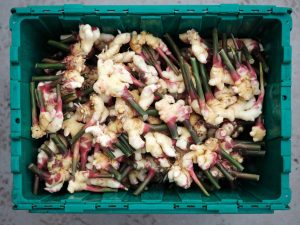
Greenhouse Guide Principle #5: Troubleshooting and Problem Management
A few years back at Ferme des Quatre-Temps, I walked into our cucumber greenhouse one morning and immediately knew something was wrong. In less than two weeks, our beautiful trellised cucumber plants had gone from vigorous and thriving to completely wilted, yellowing, and collapsing on the ground. It happened fast—and it was devastating.
At first, I suspected an irrigation issue or maybe a fungal disease. But after looking more closely and getting a lab confirmation, we discovered the culprit: bacterial wilt, a disease caused by the bacterium Erwinia tracheiphila. The real kicker? It wasn’t just the disease—it was the striped cucumber beetles that had brought it in and spread it as they fed on the plants.
Bacterial wilt is sneaky. The beetles chew on the leaves and stems, and the bacteria enter through those feeding wounds. Once it’s in, the bacteria multiply in the plant’s vascular system, blocking water flow—leading to rapid wilting and plant death. There’s no cure once infection sets in, and entire crops can be lost before you even know what hit you.
Since then, we’ve installed fine insect mesh on all our roll-up sidewalls and monitor beetle populations closely with sticky traps and row covers during vulnerable periods. That outbreak taught me a hard but valuable lesson: in greenhouse farming, prevention is everything. You learn a lot through trial and error—but you can also prepare by listening to someone who’s already been through it.
Over the years, I’ve started recognizing the patterns that lead to these problems and put systems in place to prevent them. Below are the most common issues we face in the greenhouse—and what you can do to stay ahead of them.
Botrytis
I’ve lost more tomato plants than I care to admit because of this one disease. The worst part? By the time you see it, it’s already spreading. That gray fuzz on a pruning wound? It’s the beginning of a serious problem. But here’s the thing: while you can’t cure Botrytis, you can stop it—if you know what to look for and act fast.
Over the years, I’ve developed a routine of simple but powerful tricks that have saved my crops season after season. Want to know how we use 4 a.m. venting, HAF fans, and smart pruning to keep this disease in check? Or which bio-controls and sprays actually work when things get bad? Trust me—if you’re growing tomatoes under cover be prepared!
Aphids
I’ve learned to never underestimate aphids. One day, everything looks fine—and the next, your crops are curling, sticky, and covered in these tiny sap-suckers. They hide under the leaves, multiply like crazy, and bring disease with them. If you don’t catch them early, they take over fast.
But here’s the good news: You don’t need to panic or reach for harsh chemicals. Over the years, I’ve developed a simple, reliable approach: it starts by blasting them off with water, followed by applying organic sprays, and then releasing beneficial insects at just the right time.
If you’re growing in a tunnel or a greenhouse, this is stuff you need to know. Trust me, don’t wait for an infestation to find out what you should have done.
Spider Mites
The first time spider mites showed up in my tunnel, I didn’t even know they were there. The leaves just looked a bit dry. Two weeks later, my cucumber crop was toast. These pests are tiny, fast, and ruthless—and once you see their webbing, the damage is already done.
But here’s the thing: you can stop them if you know what to do. You will need to know how to use neem oil, when to release predatory mites, and the one humidity trick that changed everything in my greenhouse. Be on the lookout for my next blog article about spider mites and how to deal with it.
Powdery Mildew
I’ve lost beautiful zucchini crops to powdery mildew, and it always starts the same way: a few white spots on older leaves that seem harmless… until they’re not. Within days, the plants stall, the yields crash, and you’re ripping out beds you should be harvesting.
If you’re growing cucumbers, squash, or tomatoes under cover, powdery mildew is coming for you sooner or later. But with the right airflow, pruning habits, and a smart spray strategy, you can stop it before it spreads.
In this article, I walk you through exactly how I prevent (and deal with) mildew outbreaks—step by step.
Whiteflies
I ignored whiteflies once, and I paid for it. What started as a few bugs fluttering around turned into yellowing leaves, sticky honeydew, black mold, and stressed-out plants. These tiny pests spread fast, and worse, they carry viruses that can wipe out your crop.
If you’re growing tomatoes, cucumbers, or any fruiting crops under cover, you need to know how to deal with whiteflies before they become a full-blown infestation. Be on the lookout for my next blog article about whiteflies and how to deal with it.
In this article, I break down exactly what I do: from sticky traps and vacuums to neem sprays and beneficial insects.
Thrips
The first time I dealt with thrips, I thought I had a nutrient issue—until I saw the silvery streaks, black specs, and distorted fruit. These pests are tiny, fast, and brutal on crops like cucumbers, peppers, and lettuce. Worse? They spread viruses you can’t cure.
Over the years, I’ve figured out how to stay ahead of them—with sticky traps, predatory mites, and targeted sprays like Spinosad. But timing is everything. Miss the window, and you’re in for trouble.
These are just a few examples, and in a nutshell, it always boils down to being prepared. Remember this: if your plants are growing awesome because of the perfect climate your greenhouse provides, pests and diseases are also in that same perfect climate to evolve. When something goes wrong, it can escalate fast. That’s why I always encourage new growers to think ahead, build good systems, and be ready to troubleshoot.
This greenhouse guide is meant to introduce you to all these key aspects of greenhouse growing—and I’m trying to pass on as much as I can. There’s so much to learn and experiment with, from crop planning and airflow to pest control and climate strategies. But you don’t have to figure it all out on your own.
Get Prepared—Master Greenhouse Farming with Confidence
This greenhouse guide offers a strong starting point, but remember that greenhouse growing is a long-term journey—one that improves with every season, challenge, and success.
If there’s one thing I’ve learned in my years of growing under cover, it’s this: success in the greenhouse doesn’t come by chance. It comes from preparation. From thinking ahead, building the right systems, and knowing how to respond when things go wrong. Because they will.
I’ve spent the last 15 years practicing, testing, failing, and learning how to master greenhouse farming. And honestly, it didn’t happen overnight. What helped me the most was learning from others who showed me how to do it—not just talking about it. That’s exactly why I created the online course Mastering Greenhouse Production. It’s the result of four years of filming and documenting everything we do in our greenhouse—what we grow, how we grow it, and why we make the decisions we do.
What took me over a decade to figure out is now available for you to learn—step by step. And considering the revenue potential of greenhouse growing, I honestly believe this could be one of the best investments you’ll ever make.
👉 If you’re ready to take the next step and unlock the full potential of greenhouse production, I invite you to join the program Mastering Greenhouse Production.
You’ll gain real, hands-on knowledge—from greenhouse setup and climate management to crop systems, pest prevention, and everything in between.


